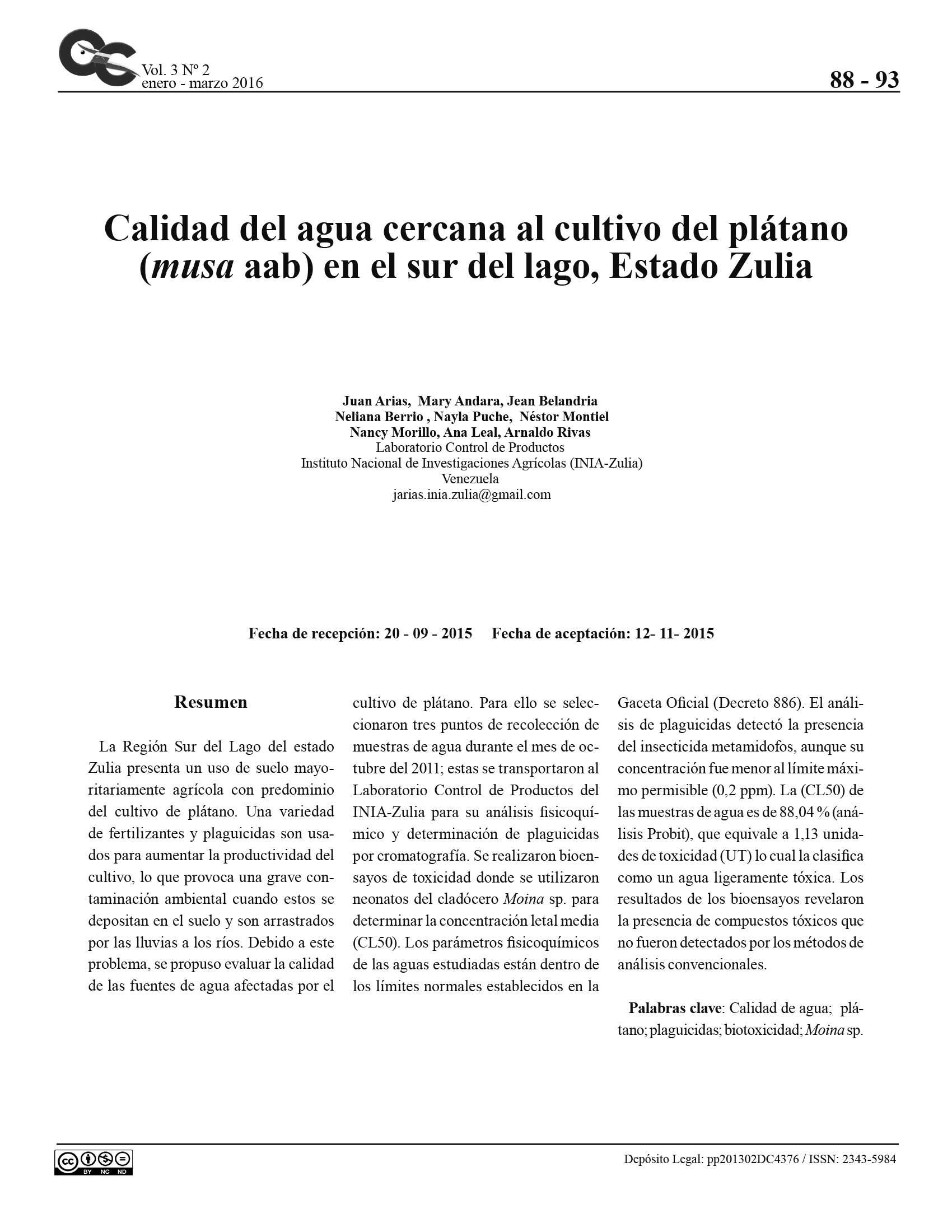Quality close to water plantain (Musa Aab) in south lake, Zulia State
Keywords:
Water quality, banana, pesticides, toxicity, Moina spAbstract
The Southern Region of the Lake in the state of Zulia presents a mostly agricultural land use with predominance of banana cultivation. A variety of fertilizers and pesticides are used to increase the productivity of the crop, which causes serious environmental pollution when these are deposited in the soil and are washed into the rivers. Because of this problem, it was proposed to evaluate the quality of water sources affected by the banana crop. For this purpose, three water sample collection points were selected during the month of October 2011; these were transported to the Product Control Laboratory of INIA-Zulia for their physicochemical analysis and determination of pesticides by chromatography. Toxicity bioassays were performed where neonates of the cladocerum Moina sp. were used to determine the mean lethal concentration (LC50). The physicochemical parameters of the waters studied are within the normal limits established in the Official Gazette (Decree 886). Pesticide analysis detected the presence of the insecticide methamidophos, although its concentration was lower than the maximum permissible limit (0.2 ppm). The (LC50) of the water samples is 88.04 % (Probit analysis), which is equivalent to 1.13 units of toxicity (UT) which classifies it as slightly toxic water. The results of the bioassays revealed the presence of toxic compounds that were not detected by conventional analytical methods.
Downloads
References
Atwood, H. (1982). Synapses and neurotransmitter. En D.E. Bliss (ed.) The biology of crustacea, Neurobiology, pp. 45-59. Nueva York: Academic.
Brooks, K., Folliott, P., Gregersen, H, Thames, J. (1991). Hidrology and the management of watersheds. Estados Unidos: Iowa State University Press/Ames.
Chirinos, D. y Geraud-Pouey, F. (2011). El manejo de plagas agrícolas en Venezuela, análisis y reflexiones sobre algunos casos. Interciencia, 36, 192-199.
Environment Canada (1999). Guidance Document on Application and Interpretation of Single especies test in Environmental Toxicology. EPS 1/RM/24. Canadá.
Esclapés, M. (1999). Protocolos estándares para bioensayos de toxicidad con especies acuáticas y terrestres. Versión 2.0. PDVSA. INTEVEP.
Farrera, R., Barroso J., Silva I., Armas C. y Serrano. G. (2002). Educación para el manejo y uso de plaguicidas en los municipios rurales: Jáuregui y Vargas, Táchira. Geoenseñanza, 7: 38-56.
International Programe on Chemical Safety IPCS (1993). Health and Safety Guide No. 79: Methamidophos. Programa Internacional de Seguridad de las Sustancias Químicas, IPCS/ Organización Mundial de la Salud, Ginebra.
Izquierdo, P., Allara, M., Torres, G., García, A. y Piñero, M. (2004). Residuos de plaguicidas organoclorados en fórmulas infantiles. Revista Científica, FCV/LUZ 14, 147-152.
Louchart, X., Voltz, M., Andrieux, P., Moussa, R. (2001). Herbicida transport to surface at field and watershed scales in a mediterranean vineyard area. Journal Environmental of Quality, 30: 982-991.
Medina, D., Prieto A., Ettiene, G. y Buscema, I. (1999). Persistence of organophosphorus Pesticide Residues in Limon River Water. Bulletin Environmental Contamination and Toxicology, 63: 39-44.
Normas para la Clasificación y el Control de la Calidad de los Cuerpos de Agua y Vertidos o Efluentes Líquidos. (1995). Gaceta Oficial extraordinaria: 5.021 del 18 de diciembre de 1995.
Decreto Presidencial N° 883, 11 de octubre de 1995. Ongley, E., (1997). Lucha Contra la Contaminación Agrícola de los Recursos Hídricos. Estudio FAO-Riego y Drenaje. 55.
Piñero, M., Izquierdo P., Allara, M. y García, A. (2007). Residuos de plaguicidas organoclorados en 4 tipos de aceites vegetales. Archivos Latinoamericanos de Nutrición, 57: 397-401.
Ramírez, M., German, F., Galar, C., Madrigal, M., UlIoa G. y Orozco, F. (1997). Toxic effeet of sodium dodecylbencensulfonate, Iead, petroluem, and their mixtures on the activity of acetylcholine esterase of Moína macrocopa in vitro. Environmental Toxicologyand Water Quality, 12: 211-215.
Sánchez, J., Ettiene G., Buscema, I. y Medina, D. (2005). Persistencia de los insecticidas organofosforados malathion y chlorpyrifos en guayaba. Revista de la Facultad de Agronomía (LUZ), 22: 62-71.
Torres, D. y Capote, T. (2004). Agroquímicos un problema ambiental global: uso del análisis químico como herramienta para el monitoreo ambiental. Ecosistemas 13: 2-6.
United States Environmental Protection Agency, USEPA. (1998). EFED Methamidophos: Revision of EFED risk assessment for the registration eligibility decision (RED). Document to include registrant´s comments. United States Environmental Protection Agency (USEPA). Office of Prevention, Pesticides and Toxic Substances, Washington DC, Estados Unidos.
Walsh, G., Bahner, H. y Horning, B. (1980) Toxicity of textile mill effluents to freshwater and estuarine algae, crustaceans and fishes. Environmental Pollution (A) 21: 169-179.

Downloads
Published
How to Cite
Issue
Section
License

This work is licensed under a Creative Commons Attribution-NoDerivatives 4.0 International License.







